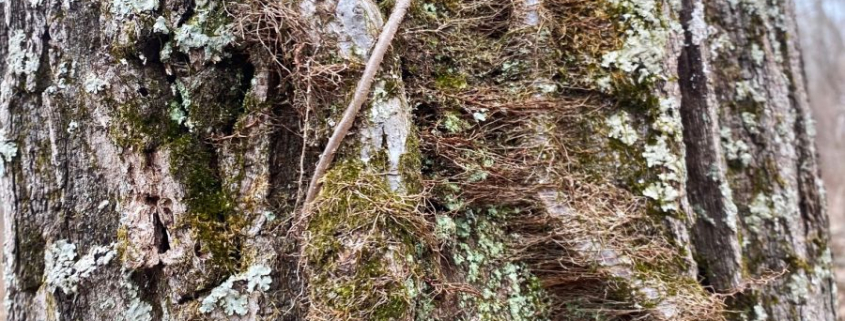March 19, 2022 on the Fire Tower Trail at Monte Sano State Park
March 19, 2022, I co-led a hike on the Fire Tower Trail at Alabama’s Monte Sano State Park for OLLI (Osher Lifelong Learning Institute at the University of Alabama in Huntsville). Chilly, mostly cloudy, and dry, the hiking weather and conditions proved perfect.
In retrospect, this hike proved special. I had been released just a week prior from the intensive physical therapy following my November 8, 2021, left shoulder replacement. I was primed for an anticipated spring of woodland exploration, focusing on the coming season replete with our region’s prolific spring ephemeral wildflowers. However, just five mornings later I suffered a stroke that kept me out the woods until a brief and labored forest hike April 29. Here’s my April 27 Post describing my efforts to retain Nature-connections close to home during my extended period of convalescence: https://stevejonesgbh.com/2022/04/27/sunrises-and-sunsets-over-the-period-of-my-stroke-convalescence/
Ashes to Ashes; Dust to Dust
Life and death are constant companions in our north Alabama forests. Nothing in our wild environments signals internal static. Although this loblolly pine appears robust, the woody bracket about eye height signals internal decay. The conk is the fruity body (spore producing structure) for the decay fungi within the bole. Perhaps a bit morbid, all living organisms begin dying the minute they are born, hatched, or germinated. Despite the death of individuals (trees, shrubs, squirrels, or insects, the forest continues.
I have a purpose for beginning this section with this particular photograph. Not only does it show a supposedly robust tree dealing with a serious decay organism, it happens to be supporting a spiraling vine. Based upon this excursion, I will dedicate a subsequent Post (watch for it) on the spiraling habits of our native forest canopy vines.
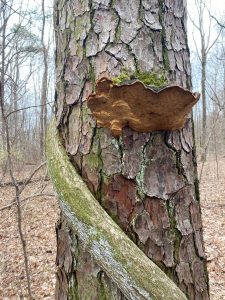
Our trail circuited south before looping back on a parallel route near the eastern plateau edge. The elevation is a consistent 1,500-1,600 feet. The forest is likewise fairly uniform, consisting of mixed oak, hickories, and declining black locusts, along with a scattering of poplars, maples, cedars, and pines. I view the forest as even-aged, likely 80-90 years, regenerated from periodic cuttings for timber and intensive firewood harvesting. Black locust and red cedar are early colonists on our cleared forests. The remaining cedar stand suppressed in the understory, failing to compete effectively for space in the main canopy. Black locust trees ascended into the main canopy but stand mostly as skeletons or weakening remnants. They are not long-lived.
Cracked cap polypore (below right) is a primary final instrument of death on black locust. However, I am undecided (based upon my own observations and the literature) whether the decay fungus caused death, or simply takes advantage of this pioneer species’ fulfilling its life-mission early and then fading, losing its ability (and desire) to fend off the pesky fungus. Its life mission? One facet is producing tasty and nutritious seeds, appealing to birds, who consume them and pass them scarified elsewhere. But that may not be the primary mechanism for assuring succession to a future forest. The USDA Forest Service indicates that locust seed production peaks from ages 15-40 years and generally ceases by age 60. So, a terminal age beyond the seed production age may serve little purpose. Of importance, locust seeds may remain viable for decades and accumulate to thousands of viable seeds per acre on the forest floor. When the next significant blow-down occurs on the plateau, the black locust seedbank may once again that black locust will thrive in the succeeding stand.
As reference, I published a Post in March documenting a similar black locust decline at Joes Wheeler State Park (https://stevejonesgbh.com/2022/03/22/black-locust-decline-and-two-champion-trees-at-joe-wheeler-state-park/).
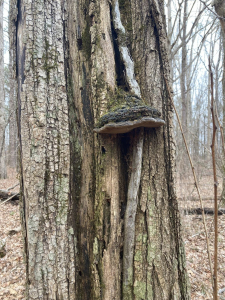
Another black locust sports a bark-less burl, indicating low tree vigor.

This black locust has succumbed. These are the mushrooms of decay fungi consuming the standing dead tree from within. Eventually, gravity will prevail, the fungi will continue, and the organic matter will incorporate into the soil. Ashes to ashes; dust to dust.
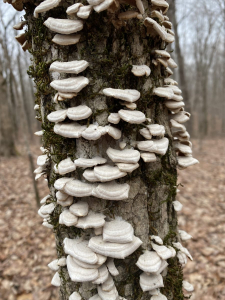
A Plateau-top Perched Wetland — a Relic from Days Past
Although the plateau-top forest retains the stark appearance of winter, the old lily pond (a footnote in the rich history of the Hotel Monte Sano resort period) offered a spring peeper chorus, hinting at the season just around the corner!
I’ve found that if a picture is worth a thousand words, a video may be an order of magnitude better than the photos. Therefore, I’m hoping to incorporate more of these short videos.
Not Indian Marker Trees
We found several trees that stimulated a discussion of Indian marker trees, remnant individual trees intentionally shaped by native Americans to designate directions to some place of special significance. I reject that any of the trees in the forest we transited meet the criterion of age necessary to place them here during Indian occupation 150 years ago. Instead, these trees are artifacts of natural processes. I refer you to my relevant Post from February 2021: https://stevejonesgbh.com/2021/02/10/indian-marker-trees-separating-folklore-from-fact/
The oak trees below suffered physical damage from a falling tree or branch, recovered from the injury, then sent a shoot vertically at the point of injury that reaches at least into the intermediate canopy.
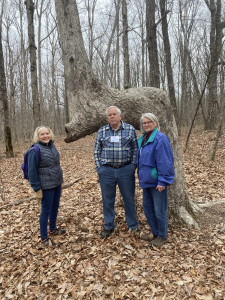
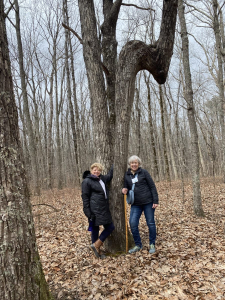
This chestnut oak is pointing the way with a skeletal arm, reminding me of the scary, haunted Sleepy Hallow woods where Ichabod Crane may have wandered near Halloween time.
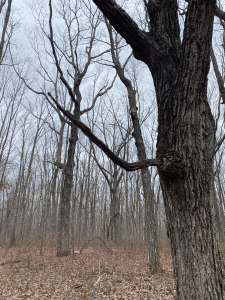
I shall never tire of seeing mystery and magic in the forests I wander. I often get lost in the imagery and fantasy of my forest wanderings.
Imagination is more important than knowledge. Knowledge is limited. Imagination encircles the world. — Albert Einstein
We found this old tortured white oak, which I am certain is older that the forest around it. A remnant from a prior forest? A property line marker tree? I have said often that every tree has a story to tell. So much in our forests lies hidden in plain sight. I enjoy trying to cipher the stories.
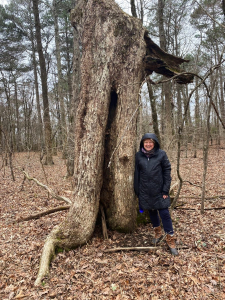
I see this individual predating the Civil War and the Hotel Monte Sano. I’d love to hear its tales!
Lichens and Mosses
Some might consider a forest merely as a collection of trees. In fact, while trees are the primary characters from our perspective, they constitute only the essential matrix. John Helms’ The Dictionary of Forestry defines forest: as an ecosystem characterized by a more or less dense and extensive tree cover. The key word is ecosystem, which Helms defines (in his immutable academic language) as a spatially explicit, relatively homogenous unit of the earth that includes all interacting organisms and components of the abiotic environment within its boundaries. I applaud Dr Helms for his concise capture of the essence of the terms forest and ecosystem, even as I celebrate and rejoice that retirement licenses me to write outside the bounds and constraints of the academic world that once held me in its grasp!
This hiskory wears a moss-coat, interspersed with lichen patches. A fine garment! We all know that Nature abhors a vacuum. The moss and lichen find the hickory bark and its collections of surficial organic matter as ideal substrate for eking a living.
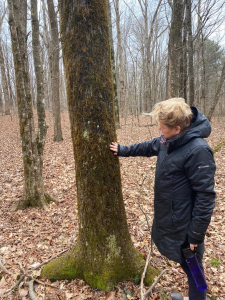
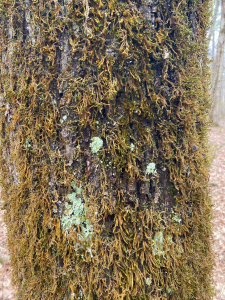
This moss carpet is even more extravagant!
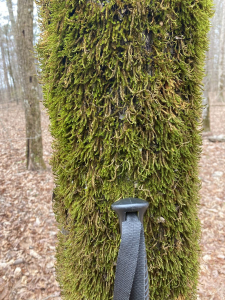
The combination of poison ivy vine roote, lichen, and moss create an ornate surface on this chestnut oak. The forest as just trees? Not even close.
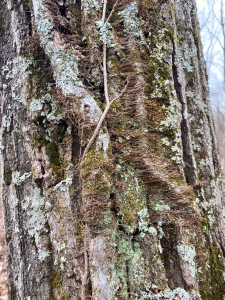
Life extends far beyond the tree matrix. Diverse plant, animal, and fungal life by count alone reaches exponentially beyond the mere hundreds of tree per acre.
A Special Discovery
During our hike I spotted first the broken chestnut oak off-trail, admiring the character expressed by its fractured top, one side with hollowed core. I then noticed, without aid of magnification that a stuffed-toy-like face seemed to be staring our way. Marsha Langlois, one of our tour group, caught this image with her telephoto lens. The stuffed toy critter is, in fact, gawking at us, I suppose wondering who we are!
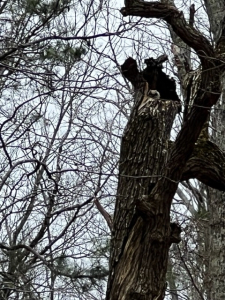
Lest you think this great horned owl baby is a stuffed animal placed high in the oak, here is an image from an online open-source collection:
Copied Online Image
I’ve said repeatedly that so much lies hidden in plain site. If I had not slowed to look closely enough to see, I would have passed beneath the old ravaged chestnut oak missing what for me was the greatest delight of the day. Borrowing from my Great Blue Heron website, I employ what I term five essential verbs to make the most of my forest forays:
Five Essential Verbs: Believe, Look, See, Feel, and Act:
- I find Nature’s Lessons because I know they lie hidden within view — belief enables me to look and see
- Really look, with eyes open to your surroundings, external to electronic devices and the distractions of meaningless noise and data
- Be alert to see deeply, beyond the superficial
- See clearly, with comprehension, to find meaning and evoke feelings
- Feel emphatically enough to spur action — that action may be as simple as sharing what I see in these Posts
The owl family is as much a part of the forest as the trees, their moss and lichen coats, the birds and mice the owls consume, and every other facet on the biotic and abiotic elements of this relatively homogenous unit of the earth!
Alabama State Parks Foundation
Thoughts and Reflections
I offer these observations:
- Lessons are written along every forest trail
- Life and death dance continuously within all forests and across all of Nature.
- Are forests are filled with beauty, magic, wonder, and awe. Occasionally we encounter special treats!
Inhale and absorb Nature’s elixir. May Nature Inspire, Inform, and Reward you!
Note: All blog post images created & photographed by Stephen B. Jones unless otherwise noted. Please circulate images with photo credit: “©2022 Steve Jones, Great Blue Heron LLC. All Rights Reserved.”
Another Note: If you came to this post via a Facebook posting or by an another route, please sign up now (no cost… no obligation) to receive my Blog Post email alerts: http://eepurl.com/cKLJdL
And a Third: I am available for Nature-Inspired Speaking, Writing, and Consulting — contact me at steve.jones.0524@gmail.com
Reminder of my Personal and Professional Purpose, Passion, and Cause
If only more of us viewed our precious environment through the filters I employ. If only my mission and vision could be multiplied untold orders of magnitude:
Mission: Employ writing and speaking to educate, inspire, and enable readers and listeners to understand, appreciate, and enjoy Nature… and accept and practice Earth Stewardship.
Vision:
- People of all ages will pay greater attention to and engage more regularly with Nature… and will accept and practice informed and responsible Earth Stewardship.
- They will see their relationship to our natural world with new eyes… and will understand more clearly their Earth home.
Tagline/Motto: Steve (Great Blue Heron) encourages and seeks a better tomorrow through Nature-Inspired Living!
Steve’s Three Books
I wrote my books Nature Based Leadership (2016), Nature-Inspired Learning and Leading (2017), and Weaned Seals and Snowy Summits: Stories of Passion for Place and Everyday Nature (2019; co-authored with Dr. Jennifer Wilhoit) to encourage all citizens to recognize and appreciate that every lesson for living, learning, serving, and leading is either written indelibly in or is powerfully inspired by Nature.
I began writing books and Posts for several reasons:
- I love hiking and exploring in Nature
- I see images I want to (and do) capture with my trusty iPhone camera
- I enjoy explaining those images — an educator at heart
- I don’t play golf!
- I actually do love writing — it’s the hobby I never needed when my career consumed me
- Judy suggested my writing is in large measure my legacy to our two kids, our five grand kids, and all the unborn generations beyond
- And finally, perhaps my books and Blogs could reach beyond family and touch a few other lives… sow some seeds for the future
All three of my books (Nature Based Leadership; Nature-Inspired Learning and Leading; Weaned Seals and Snowy Summits) present compilations of personal experiences expressing my (and co-author Dr. Wilhoit for Weaned Seals and Snowy Summits) deep passion for Nature. All three books offer observations and reflections on my relationship to the natural world… and the broader implications for society. Order any and all from your local indie bookstore, or find them on IndieBound or other online sources such as Amazon and LifeRich.



